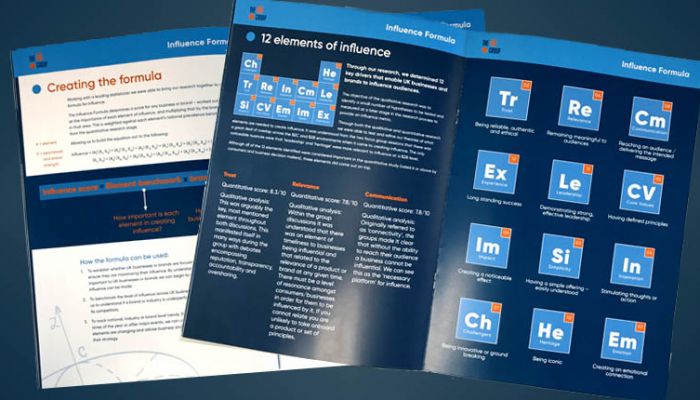The Formula for Influence?
The PHA Group recently published its Influence Formula, new research that aims to determine how influential any brand or business truly is. Vuelio, which is no stranger to measuring influence, joined the launch event to discuss how different people measure influence in different ways.
The Vuelio Influencer Rating, used to score and rank media professionals from journalists to bloggers, uses over 40 data points and our proprietary AI to determine a unique score for individuals in our Influencer Database. The PHA Group formula takes a different approach to measuring influence – it focuses on organisational influence, uses a panel of consumers, and bases its measurement on 12 distinct elements:
- Trust
- Relevance
- Communication
- Experience
- Leadership
- Core values
- Impact
- Simplicity
- Inspiration
- Challengers
- Heritage
- Emotion
The first three – Trust, Relevance and Communication – were determined to be the most important by The PHA Group’s research group.
All relationships are built on trust and for The PHA Group, this is fundamental for the formula. Trust is a common part of influence measurement – it is one of the Reputation Institute’s (RI) RepTrak measurements, which also include ‘Esteem’, ‘Admire’ and ‘Feeling’. RI measures reputation rather than influence, but the two are inextricably linked.
At Vuelio, our Influencer Rating is used to identify individuals our users wish to build relationships with rather than to determine the current status of that relationship. This shows the different stages of influence as it is consumed by an audience – initially influence is used to attract consumers/clients/PRs (which is where the Vuelio Influencer Rating comes in) then it is used to justify reputations (what RI does) and show areas of strength and weakness (part of how The PHA Group is measuring it).
Klout was probably the most famous example of the first stage of influence consumption – used to publicly rank people on Twitter. The recent downfall of Klout was attributed to the advent of the GDPR but it had already lost its own influence through loss of trust and its declining reputation. While it is unclear what the Klout formula was, it is clear it had its flaws as it often ranked noisy people over genuinely influential people. Klout was one of the data points for our AI-led Influencer Rating, but it was just one of many, which is why Klout’s demise didn’t materially affect the Rating.
Back to human intelligence, The PHA Group worked with a statistician to create the final Influence Formula, based on the 12 elements. The formula looks like this:

There are three ways The PHA Group believes the formula can be used:
- To establish whether UK businesses or brands are focusing their efforts in the right areas to ensure they are maximising their influence
- To benchmark the level of influence across UK businesses, brands and sectors
- To track national, industry or brand level trends
To put it to the test, The PHA Group used the formula on Forbes’ Top 5 Global Brands of 2017: Apple, Google, Microsoft, Facebook and Coca-Cola.
So, what were the results?
Google came out on top, with a high score for ‘relevance’; Apple was second, noted for its high score in ‘instilling emotion’; Microsoft was third; Coca-Cola fourth; and Facebook brought up the rear in fifth. Facebook was considered the least likely to be a ‘challenger’ and the ‘most untrustworthy’ – and this was before the recent troubles it has faced.
The PHA Group believes the formula will have a multitude of uses for the comms industry, from being able to identify how a brand is performing and where it needs to improve, to using the score as a measurement for the evaluation of comms activity.
The last point is surely the Influence Formula’s crowning glory; what brand wouldn’t want to know how influential it is and measure how that changes – especially when compared to the competition?
If you’d like to find out how influential your media contacts are, check out the Vuelio Media Database.



Leave a Comment